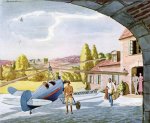- Joined
- Oct 30, 2003
- Messages
- 18,391
- Location
- Santa Maria, California
- Aircraft
- Givens Predator
- Total Flight Time
- 2600+ in rotorcraft
Miranda is building a gyroplane with fixed pitch.
Miranda is building a gyroplane with fixed pitch.
Flying the two place tandem gyroplane I fly it is not unusual for the rotor rpm to increase from a little over three hundred rotor rpm in level flight to a little over four hundred rotor rpm in a steep banked turn.
I feel this increase in rotor rpm is from the increased load in a turn.
In all the gyroplanes I have flown it is my observation flying nose high (aft cyclic) will reduce the rotor rpm.
I feel this is because of the reduced indicated air speed.
In all the gyroplanes I have flown it is my observation that the flair to land (aft cyclic, raising the nose) will increase rotor rpm, reduce airspeed and arrest the descent.
Please don’t get off track Brian, Miranda was asking something very specific about gyroplanes.
Thank you, Vance
Miranda is building a gyroplane with fixed pitch.
In the hundreds of turning autos I did to the ground during my Army training, and in the dozens of turning autos I did in my civilian training to a 3 foot hovering power recovery...
...The ONLY reason that was ever discussed for having to add pitch to avoid the rotor overspeeding, was the change in the angle that the resultant relative wind enters the rotor system. A slight amount of aft cyclic to cause the turn causes a slight change in the entry angle of the relative wind...which adds a tremendous amount of rotational force to the blades.
Now I do admit that the most recently FAA Published Advisory Circular says the reason for RPM increase is the increased load on the rotor.
Flying the two place tandem gyroplane I fly it is not unusual for the rotor rpm to increase from a little over three hundred rotor rpm in level flight to a little over four hundred rotor rpm in a steep banked turn.
I feel this increase in rotor rpm is from the increased load in a turn.
In all the gyroplanes I have flown it is my observation flying nose high (aft cyclic) will reduce the rotor rpm.
I feel this is because of the reduced indicated air speed.
In all the gyroplanes I have flown it is my observation that the flair to land (aft cyclic, raising the nose) will increase rotor rpm, reduce airspeed and arrest the descent.
Please don’t get off track Brian, Miranda was asking something very specific about gyroplanes.
Thank you, Vance


